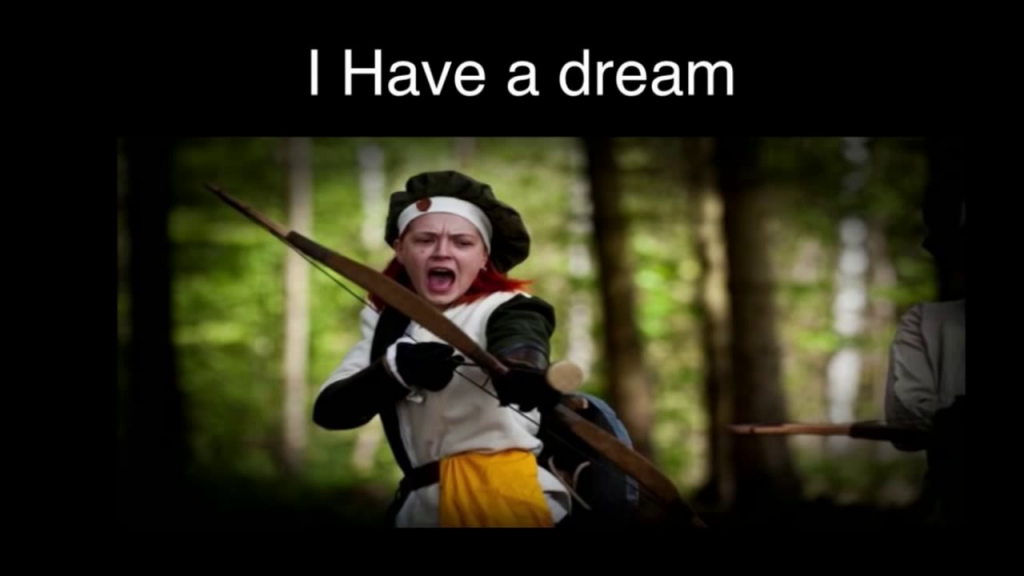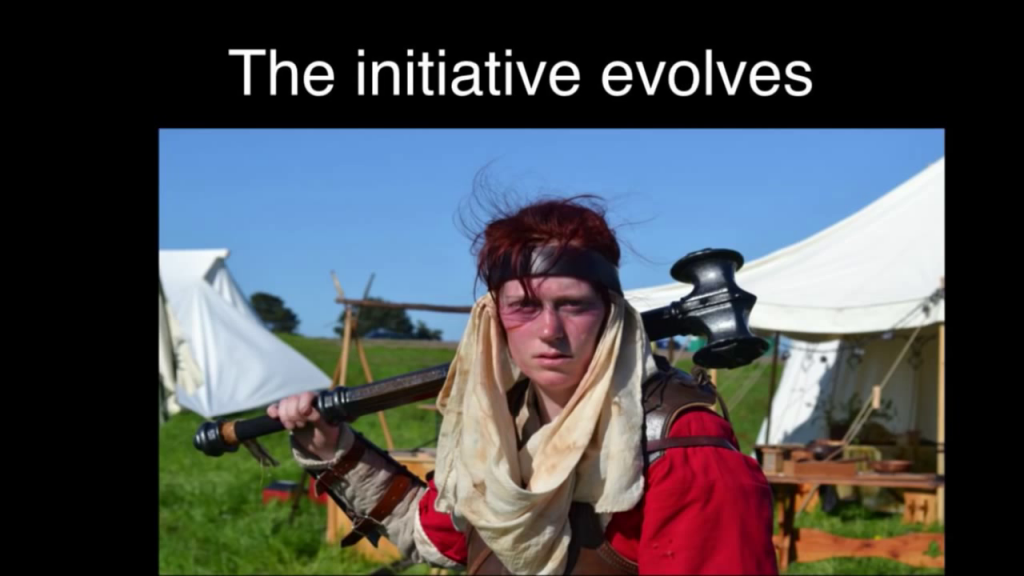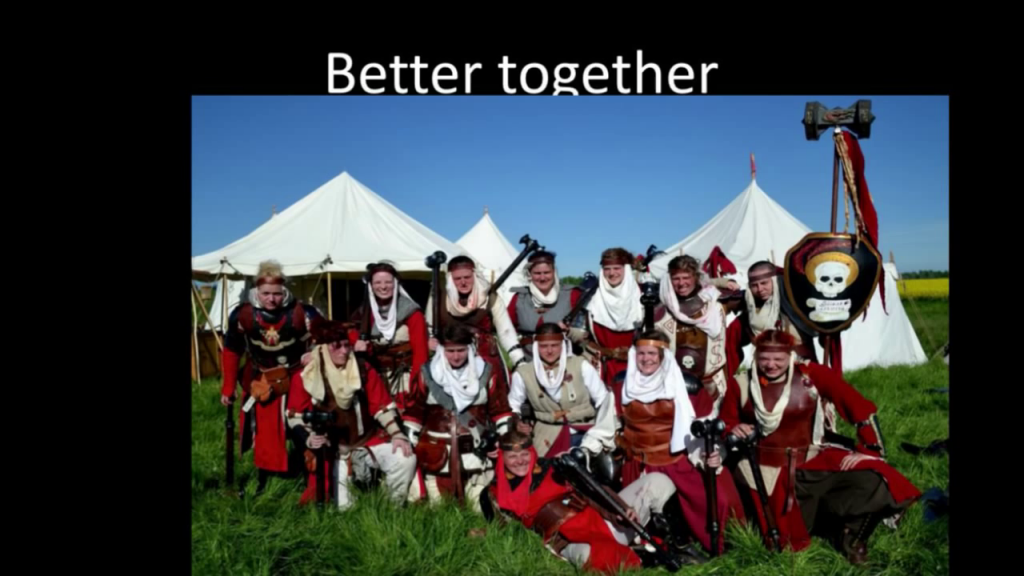I’m going to talk to you about something not very international. Which is surprising because this is not just Nordic larp talk, this is international larp talk. I’m going to talk to you about a Danish initiative that, a feminist initiative, called the Girls In Armor movement, wich started as a regiment of all women made for a Danish larp called Warlarp, which went [on] to be an official organization with members of both sexes, and is now some sort of loose network that supports this system for people who are interested in feminism and women’s rights.

What’s up with the name, Girls in Armor? It’s a really stupid name. We know. It started up as a joke or a pun about an old Danish movie about women and enrolling themselves in the army. It was from the 70s. We bitterly regretted giving the group the name then, but it sort of stuck and now it has nostalgic value.

This is me. And I’m going to say that I’m really terrible at making this sort of presentation. Not giving the presentation but actually making what’s on the screen. So now I just have pictures of us running around in larp gear.

Warlarp is a series of Danish larps which focuses on battles, epicness, soldier lives, and badass costumes. It’s not very complicated. It has about five hundred participants every time. It runs once a year with a different organizing group, and it’s about three days.
In 2009, when we began this initiative, there weren’t really that many women around to play these games. They were usually, “I’m the musician. I’m the one who carries the standard. I’m at home making food.” If there were women participating in regiments, there was usually just one per regiment, and the regiment is like ten to thirty, maybe forty people for the largest of them. So, not many women were around to play these games.
So, one night we sat down a bunch of women. We had smoked a lot of cigarettes and we had drunk a lot of red wine, and someone said, “We’ll do a group of only women.” And everybody said, “Yeah!” and the game was on. So now we’d said it and we had to do it.

So, the whole project sort of started for our own sake. Usually when you make this kind of feminist initiative, it starts with people reading a bunch of feminist theory. I know, because I read a bunch of feminist theory all the time. But none of us really knew anything about feminist theory and how to be a proper feminist activist group. We did this for our own sake. We did it because we thought, “Warlarp. That sounds like fun.” Some had been, some had not. So we were kind of like, “We’re going the whole way.”
With Warlarp, we kind of wanted to challenge how women were portrayed in these kinds of larps, when you use super regular stereotypes with women like, “You go and cook. And I go and fight.” We wanted to challenge that.
We also wanted to make it seem where no one felt like the weak link. If you’re one woman in a group of ten men and you have to be very physical— Aand you have to be when you play Warlarp. There’s a lot of running around and fighting and getting hit in the head with swords and axes. And you kind of tend to feel like the weak link. And having a group of women—all women—doing this, then nobody felt like the weak link, so it was kind of like an act of empowerment.
And we wanted to show our male friends. They were laughing a little bit at us, and we wanted to prove that we could do this. We could all organize this whole shebang, and so we did.

And most importantly, we wanted to show that we could function as a regiment as well as anybody. So, we found about seventeen women who wanted to participate with us. We fundraised €4,000 to make costumes that fit women’s bodies. And we made a ton of costumes. At one point, I actually had a dream of being a sewing machine.

We had character workshops and training days. And at the game, we were awesome. We won battles. Not all but a proper amount. And we got praise from all the other Warlarp participants and organizes. So, when we came home, we had success and felt pride. So, what was wrong?
Well, we discovered something, that we went from being just a bunch of women running around and playing Warlarp, to being an actual feminist group. And that was that in the duration of the larp, we were treated so much more differently because we were women. And in Warlarp, gender doesn’t really matter. It’s a game about being in the Warhammer fiction. And then you fight the other army. And then you go back and then you say, “Yay, we lost!” or, “Yay, we won!” And then you go out and fight some more.
It’s not a deep game. It’s not a deep emotional game. And gender is not an issue. So, why was it that we had random soldiers coming up to us and asking, “Hey, I have a son at home. Could could you maybe marry him?” And people were asking, “Oh, but why are you in this war?” And I would look at him and say, “But why are you in this war? Maybe because we both signed up for the same larp.” And at some point another regiment made us a homemade wooden dildo because “that’s probably the sort of thing you miss.” Yeah, great. So, having your gender be an issue or being something that the other players responded to constantly and all the time was kind of really fucking annoying when you’re playing a game where gender doesn’t really matter.

So we came home with a dream. We wanted to make the Warlarp more accessible to women. We wanted to talk and debate women’s role in these kinds of larps. And we wanted to ask simple questions like, when you have a fantasy fiction, when does gender matter? When it it important and when is it not?

So the initiative evolved quite a lot from there. We became an official organization with members, and we had a spot on the [?] board and stuff like that. We wrote a bunch of articles. We debated a lot. We made a ton of debate on Facebook and social media. We also did a lot of shitstorms, which I’m not really proud of, but yeah. I’ll tell you about all the mistakes we made later. This is not the time.
We went to some more Warlarps and looked epic. And most importantly, we talked. We talked to a lot of people and not on the web site. Having your like platform with this kind of larp for five hundred people, mostly men, it gives you a lot of people to talk to, and a lot of them don’t agree with you. But we made an issue out of it to try to be polite. These people, they were not evil, they were not vicious. They just didn’t understand what it’s like to have your gender used against you in a larp where gender is clearly not the point. And we tried to give credit and support to other women, women which we did not know. Because we felt that that was important and that was kind of the whole empowerment thing.

So apparently something worked. We got a bunch of more allies. People stepping forward and saying, “Hey, I agree with you, and I will take this fight.” Which was great, because we would never be able to do this if we didn’t have a bunch of allies, both men and women. And we could see that slowly, people were beginning to talk a lot more about gender in Warlarp, but also in other kinds of larp. We had organizers call us or write us asking, “Hey, how do I make this game more accessible to women?” And we got in touch with a bunch of badass women who have had the same struggle, and we bonded with them, and we learned from them.

So, then it got wider than just Warlarp and fantasy games. Many of us became real feminists, not just larp feminists. I know there’s no such thing. But for me personally, it became a way of looking at society and how it’s structured and how it functions.
We also began to reflect a lot about what are women’s roles off-game. As organizers, as playmakers, a scenario writers. All that stuff. And obviously there were a lot of women before us who made all these things, and were all these things. But they were scattered, and I thought that they were hard to reach. So, we cannot begin to reflect, how can I be in that position? How can I be a larp organizer or a scenario writer, or all this stuff?
And we began to push each other, and to encourage each other to stand up and to claim that fame, and to do that project. And we slowly closed down the “official” part of the organization and became more like a network which supported each other, and— “I’m not sure whether I should do this thing.” Yeah, you go and do that thing, and we support you, and we believe in you. And that is probably one of the most important things to come out of this initiative.

So today it’s been six years since we made the first Girls In Armor project. And today we have been main organizers at the Danish convention Fastaval forum, and main organizers at Knudepunkt. People have been making tons of larps. People have been scenario writers at [?], Fastaval, and Grenselandet. People have been sitting on boards in various organization. And I’m talking about all the women who have somehow been a part of or affiliated with the Girls In Armor movement. So, we really really evolved ourselves in this process, and hopefully we pulled a lot of other women up with us because we’re going onwards and forwards.

Network is the thing I want to— If I had to sum up the Girls In Armor movement with one word, it would be “network.” It’s that support system. It is that understanding of the other person’s struggle. Being sort of marginalized as a woman in Danish larp because there aren’t so many, I can see that it’s changing now. There are so many more visible women doing so much more awesome stuff. I’m not saying that we did it. But I’m saying that we maybe did some of it. Maybe we encouraged someone. I hope so. But we definitely made an effort to change how women are perceived, and how women are involved in Danish larp. Thank you.
Further Reference
Overview blog post for the 2015 Nordic Larp Talks, and for this presentation
